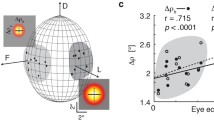Abstract
Honeybees were trained to fly a specific distance, the same over trials, down a tunnel for a reward. After training, they were tested occasionally with the reward absent. On tests, bees fly to or just past the expected place of reward, then turn around and fly back. After some distance, they turn back again, and may continue turning back and forth a number of times. Past research has shown that distance estimation in this task is based on the retinal flow of visual texture on the walls of the tunnel. Here we measured the errors in distance estimation as a function of training distance. Errors were measured as the standard deviation across trials of the positions of the first two turns (Turn1 and Turn2), and of the Middle (average of Turn1 and Turn2) and Spread (difference between Turn1 and Turn2). All errors were proportional to the training distance, thus obeying Weber’s law. Models of possible mechanisms underlying this phenomenon are discussed. The mean Spread matches the errors in Turn1 and Middle, suggesting that the bee chooses the spread of its search to match the expected odometric error.
Similar content being viewed by others
Author information
Authors and Affiliations
Additional information
Received: 28 April 1998 / Accepted after revision: 19 November 1998
Rights and permissions
About this article
Cite this article
Cheng, K., Srinivasan, M. & Zhang, S. Error is proportional to distance measured by honeybees: Weber’s law in the odometer. Anim Cogn 2, 11–16 (1999). https://doi.org/10.1007/s100710050020
Issue Date:
DOI: https://doi.org/10.1007/s100710050020




